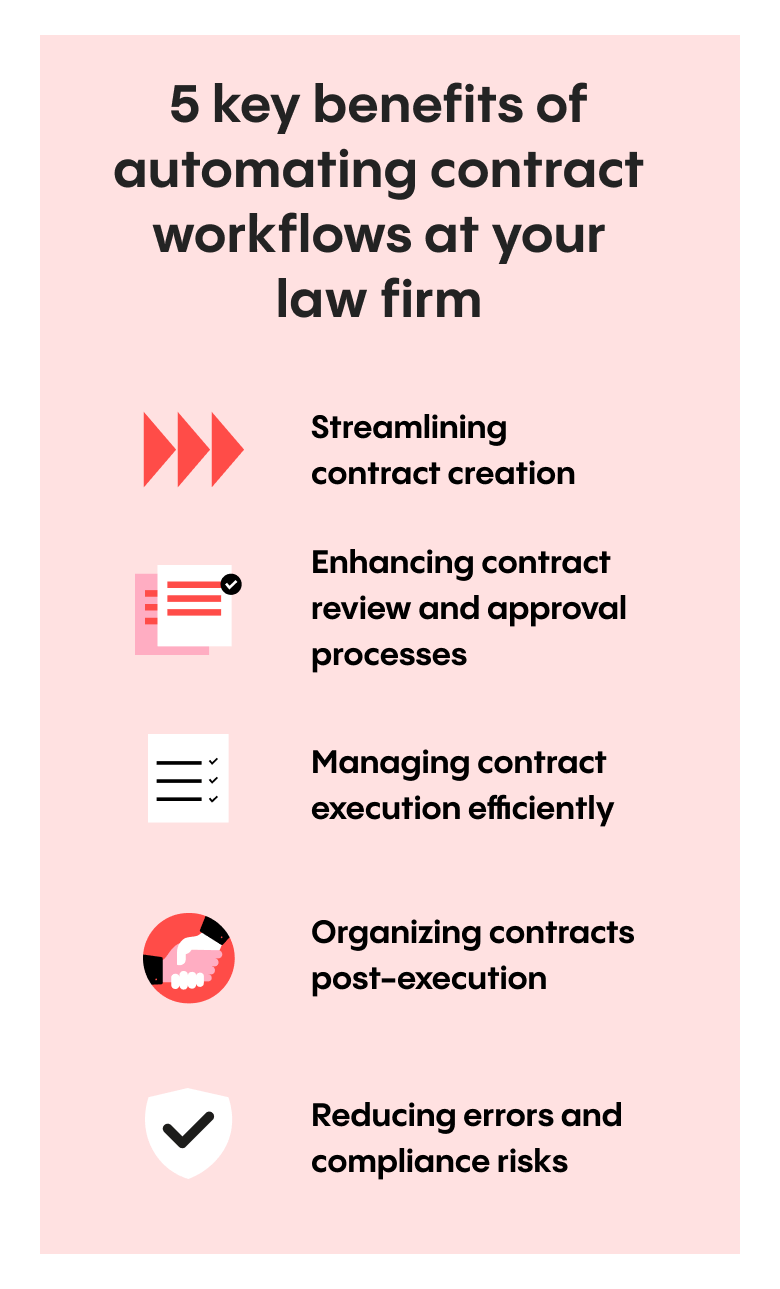Does your law firm often grapple with the complexities of managing contract processes? Many legal professionals face challenges such as time-consuming drafting procedures, error-prone manual reviews, and cumbersome contract repositories.
Workflow automation serves as a potent solution to these challenges, offering a streamlined approach to contract management. At the core of this solution is contract automation, which redefines traditional contract management methods by introducing automated tools for drafting, reviewing, managing, and organizing contracts.
Here, we’ll take an in-depth look at how automation can streamline many of your contract workflows — helping you reduce errors and compliance risks, and maximize productivity.
H2 The basics of workflow automation in law firms
At a law firm, workflow automation means implementing software solutions to automate routine tasks in contract management. This approach streamlines processes from drafting to execution and beyond, enabling you to focus on more strategic aspects of your work.
Contract automation differs significantly from traditional contract management, which relies heavily on manual effort. It enhances speed, accuracy, and consistency in handling legal documents. By adopting workflow automation, your law firm can enhance productivity, reduce error rates, and improve overall contract management efficiency.
To see how, let’s take a look at five key benefits of automating contract workflows at your law firm.
- Streamlining contract creation
- Enhancing contract review and approval processes
- Managing contract execution efficiently
- Organizing contracts post-execution
- Reducing errors and compliance risks
Here’s a deeper look at each of these five benefits.
1. Streamlining contract creation
Automation makes contract creation much faster and more efficient in a number of ways. For example:
- Automated drafting: Using templates allows you to generate legal documents swiftly.
- Standardization: With a library of standardized clauses at your disposal, you can quickly assemble contracts that align with your firm’s legal standards and client requirements.
2. Enhancing contract review and approval processes
Automated processes significantly enhance the review and approval of contracts. For example:
- Automated workflows: Auto-routing contracts through review stages ensures that each document gets seen and approved by the right people, in the right order.
- Compliance checks: Automatically scanning contracts for compliance with laws and regulations helps safeguard your firm against legal risks.
3. Managing contract execution efficiently
Automation introduces many features that streamline and secure contract execution, including:
- E-signatures: Electronic signatures allow for quick and secure signing (execution) of documents, with built-in identity verification.
- Alerts and reminders: Automated notifications make sure relevant team members and clients are aware of upcoming deadlines or required actions.
4. Organizing contracts post-execution
Automation simplifies and improves post-execution contract organization in a variety of ways. For instance:
- Automated storage: A digital repository allows for easy categorization and indexing of contracts, making them readily accessible when needed.
- Easy retrieval: You can quickly locate any contract or specific clauses within seconds, thanks to advanced search capabilities and optical character recognition (OCR).
5. Reducing errors and compliance risks
Automation crucially reduces many types of errors and compliance risks in contract management. For example:
- Minimize human error: By automating routine tasks such as data entry and clause selection, you can significantly reduce the likelihood of mistakes.
- Risk management: Automated contract management systems give you clearer insight into your obligations, enabling you to mitigate risks more effectively.
How to implement contract workflow automation at your law firm
Here’s a step-by-step checklist for rolling out contract automation in your law practice.
- Assess current processes. Identify areas that are inefficient or prone to errors. Pinpoint specific aspects of your workflows that can benefit from contract automation.
- Define your objectives. Clearly define what you aim to achieve with workflow automation – for example, reducing contract turnaround time, minimizing errors, or improving compliance.
- Select the right tool. Research and select a contract automation tool that aligns with your firm’s needs. Consider factors like user-friendliness, integration capabilities with existing systems, and customer support.
- Customize workflows. Customize the workflows within the automation tool to match your firm’s specific contract management processes.
- Train your team. Train your staff on how to use the new system. Training should cover how to create, review, and manage contracts using the tool.
- Run a pilot test. Before full-scale implementation, conduct a pilot test with a few contracts to identify any issues and make necessary adjustments.
- Implement firm-wide. Once satisfied with the pilot, roll out the automation tool across the firm. Provide ongoing support to address any queries or issues.
- Monitor and gather feedback. Monitor the system’s performance and gather feedback from users. This feedback is crucial for making any adjustments and improving the system.
- Update and maintain. Keep the system updated with the latest legal standards and technological advancements. Regular maintenance keeps your tool effective and relevant.
In short, implementing contract workflow automation requires careful planning, but the resulting improvements in efficiency, accuracy, and compliance can significantly benefit your law firm.

